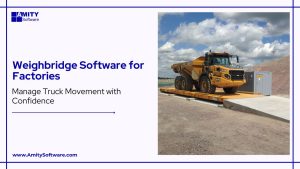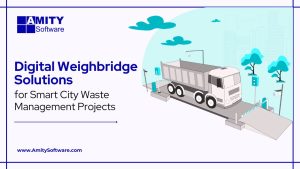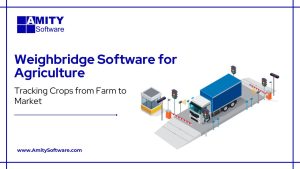In modern logistics, efficiency is measured in seconds and accuracy in grams. Weighbridge software for logistics bridges the gap between manual weighing systems and the fast-paced digital supply chain. It automates vehicle weighing, ensures regulatory compliance, and connects data seamlessly across operations.
In short, it helps logistics companies weigh faster, record more accurately, and stay compliant without the paperwork that slows dispatch.
What Is Weighbridge Software for Logistics?
Weighbridge software is a digital platform that connects weighing hardware—such as weighbridges, RFID tags, and sensors—with logistics management systems. Its main purpose is to automate the process of weighing vehicles, recording weight data, and transferring that information to the company’s operational or accounting systems.
Key Functions and Components
- Vehicle identification and automatic tare/gross weight capture
- Digital ticket generation linked with dispatch and delivery records
- Integration with ERP, TMS, and RFID systems
- Real-time reporting for audits and performance tracking
How It Fits Into Modern Logistics
In a logistics network where hundreds of trucks move daily, the weighbridge acts as a checkpoint for accuracy and accountability. The software ensures that every truck leaving a site carries the right load, that weights are recorded automatically, and that data flows into the central logistics system without manual entry.
Why Logistics Companies Need Weighbridge Software
Logistics operations face constant pressure to improve turnaround times while meeting strict compliance requirements. Traditional manual systems make this difficult—tickets get misplaced, human errors creep in, and data rarely syncs across departments.
|
Operational Challenge |
How Weighbridge Software Solves It |
|
Manual ticketing errors |
Automated ticketing ensures accuracy |
|
Weight discrepancies |
Real-time calibration and digital logs |
|
Long waiting times |
Automated processes speed up weighing |
|
Non-compliance risks |
Digital records meet audit standards |
|
Fragmented data systems |
Centralized database for fleet and logistics data |
By automating these processes, weighbridge systems help reduce manual errors and improve both transparency and speed across the logistics chain.
Core Benefits of Using Weighbridge Software in Logistics
Improved Accuracy and Data Integrity
The software eliminates human error from the weighing process. Each load is measured precisely, and data is automatically stored with time, date, and vehicle identification. This ensures auditability and prevents disputes over under- or over-loaded vehicles.
Faster Turnaround Time
Automation shortens the time trucks spend at the weighbridge. In several case studies, companies have reported up to 20% faster vehicle throughput after implementing automated systems. Dispatch teams receive instant weight confirmation, allowing vehicles to move without delay.
Enhanced Compliance and Traceability
Compliance with OIML standards, axle load regulations, and national transport laws is simplified through digital documentation. Every record is stored and easily retrievable for audit or regulatory checks.
Real-Time Visibility and Fleet Monitoring
With logistics weighbridge software that includes vehicle tracking, managers can monitor fleet movement, analyze delays, and optimize dispatch schedules using accurate weight and location data.
Seamless Integration With Existing Systems
Modern platforms integrate directly with ERP and TMS environments. This means weighbridge data automatically updates dispatch, billing, and inventory records, closing the gap between physical operations and business reporting.
How Cloud-Based Weighbridge Software Transforms Transport and Logistics
Cloud-based weighbridge software for transport and logistics takes automation a step further. Instead of storing data locally, it connects multiple weighbridges and locations through a secure online platform.
Multi-Site Data Access
Fleet and logistics managers can view all site data from one dashboard. This is especially useful for 3PL operators or distribution networks managing multiple depots.
Remote Monitoring and Analytics
Performance metrics, such as average weighing time or compliance rates, are available in real time. Decision-makers can identify bottlenecks quickly and act without being physically present.
Reduced Maintenance and Downtime
Cloud deployment ensures that updates, backups, and patches are handled remotely. This minimizes downtime and keeps the system compliant with the latest industry standards.
Real-World Application: A Logistics Case Example
A regional freight company operating across five distribution sites faced recurring issues: manual ticket duplication, inconsistent weighing records, and audit delays. After adopting a digital weighbridge management system for logistics, they saw immediate improvement.
Results after six months:
- 18% reduction in truck turnaround time
- 25% fewer data entry errors across all weighbridges
- Full compliance with axle load regulations
- Seamless synchronization of weight data with their ERP system
The automation allowed the company to maintain accurate, site-wide weighing data while improving operational transparency.
Integrations and Technology Backbone
The strength of weighbridge software lies in its connectivity. Its success depends on how well it integrates into the wider logistics framework.
1. ERP and TMS Integration
An ERP-integrated weighbridge system syncs each weighing transaction with order and dispatch data. This eliminates double entry and ensures accurate billing and reporting.
2. IoT, RFID, and Sensor Connectivity
IoT sensors capture live weight, temperature, or axle load data. RFID tags automatically identify vehicles as they enter and exit, reducing queue times and manual data input.
3. Data Management and Security
Weighbridge data management software for logistics hubs encrypts information and stores it securely in the cloud. Access is role-based, ensuring that compliance data is protected and tamper-proof.
Compliance and Industry Standards
Digital weighbridge systems are built around global and regional compliance frameworks.
- OIML Certification: Ensures weighing accuracy and international recognition.
- Axle Load Regulations: Supports transport laws by maintaining accurate axle and gross weights.
- Audit Trail Management: Each transaction is logged with a timestamp and user ID for accountability.
- Calibration and Verification: Automated alerts ensure weighbridge accuracy stays within limits.
Reference: OIML.org – International Organization of Legal Metrology
Choosing the Best Weighbridge Software for Logistics Companies
Selecting the right system requires balancing technical capability with operational needs.
Key Features to Look For
- Integration with ERP and logistics systems
- Automated ticketing and reporting
- Multi-user access with role management
- Real-time analytics dashboard
- Remote calibration and alert systems
Common Mistakes to Avoid
- Choosing software without future scalability
- Ignoring compatibility with existing ERP or IoT systems
- Underestimating the importance of compliance reporting
A well-chosen solution not only automates weighing but becomes part of a connected logistics ecosystem that improves efficiency and visibility.
Future Trends in Smart Weighbridge and Logistics Automation
As logistics continues its digital evolution, weighbridge technology is keeping pace.
- AI-Driven Predictive Maintenance: Systems can forecast when calibration or maintenance is needed.
- Blockchain-Enabled Ticketing: Ensures tamper-proof, verifiable weight records.
- Sustainability Integration: Smart analytics optimize load distribution, reducing fuel use and emissions.
- IoT Expansion: Continuous monitoring of environmental conditions during weighing and transport.
Together, these trends point toward a future where smart weighbridge software becomes a core part of logistics optimization rather than a standalone tool.
FAQ
In a logistics environment where every minute and every kilogram matter, weighbridge software for logistics is no longer a support tool—it is a strategic system that connects accuracy with efficiency. It replaces manual guesswork with data-driven precision, strengthens compliance, and delivers visibility across the entire transport chain.
Whether managing a single depot or a nationwide fleet, adopting a digital weighbridge management system helps logistics firms work faster, reduce losses, and build operations on verifiable, reliable data. In the long run, the organizations that weigh smarter will move smarter.
FAQ
1. What is weighbridge software in logistics?
It’s a system that automates vehicle weighing and connects the data with logistics operations, improving speed, accuracy, and compliance.
2. How does weighbridge software reduce costs?
By cutting manual labor, minimizing errors, and shortening truck waiting times, it reduces operational overheads.
3. Can weighbridge software integrate with ERP or TMS systems?
Yes. Integration allows real-time weight data to flow directly into dispatch, inventory, and billing systems.
4. Why choose cloud-based weighbridge software?
It offers centralized data access, remote management, automatic updates, and better data security.
5. How does it ensure compliance?
By maintaining digital records that align with OIML and transport regulations, enabling full audit readiness.

































